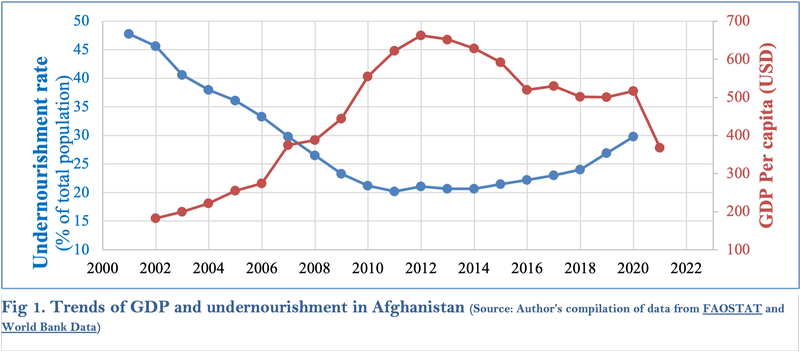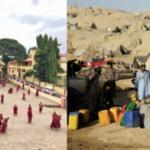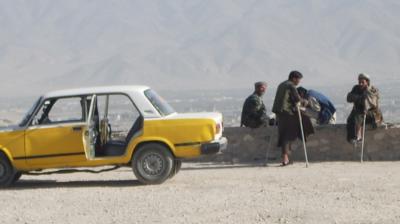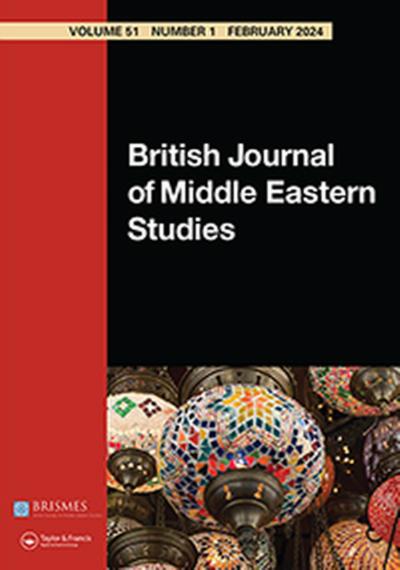Understanding and addressing poverty and food insecurity in Afghanistan
Poverty and food insecurity in low-income, conflict-prone countries
The two decades of economic development in Afghanistan
Employment transition and landscape change
Environment, agriculture and landscape change
How to cite this publication:
Yograj Gautam (2023). Understanding and addressing poverty and food insecurity in Afghanistan. Bergen: Chr. Michelsen Institute (CMI Insight 2023:1)
An estimated 28 million Afghans, more than two thirds of the country’s total population, struggle to put food on the table. A wide array of socio-economic and environmental changes has led to this crisis. This CMI Insight documents the changes and illustrates how they are together shaping farming, off-farm employment, food security and livelihoods. Based on research conducted in the Kabul region of Afghanistan, the Insight highlights two main factors that have contributed to the grave situation. First, over the past two decades there has been a significant transition of employment from farming to the construction and urban-based service sectors that has turned out to be unsustainable and collapsed after the Taliban takeover of the country in 2021. Second, environmental changes are collectively placing severe constraints on farmers and the country’s agricultural sector as a whole as they lead to drought, water scarcity, and changes in land use from farming to built-up areas. This Insight highlights that while the political change in August 2021 triggered sudden poverty and hunger, longer-term multiple socio-economic and environmental changes contributed to shaping the context for vulnerability. Therefore, while short-term relief is necessary to save people from acute hunger, building institutions to address enduring multiple structural challenges is equally important for achieving sustained well-being in the longer run.
Main points
- An estimated 28 million people, more than two thirds of the total population in Afghanistan, are suffering hunger and are in immediate need of humanitarian assistance for survival.
- The high economic growth of the 2000s led to a significant employment transition from farming to non-farm, urban-based employment, but the process was not even, inclusive and sustained. This led to massive unemployment after the Taliban takeover of the country in 2021.
- Prolonged droughts have hampered the revitalization of agriculture for the rural Afghans. Severe water scarcity in the urban area has meant that people struggle to secure water even for household consumption.
- Transferring food and multi-purpose cash assistance and providing basic health services can save lives in the current crisis. The Afghan government and aid agencies should focus on water management and climate adaptation programs to achieve the sustained well-being of the farming-based population.
Poverty and food insecurity in low-income, conflict-prone countries
Globally, an estimated eight million people live in extreme poverty and food insecurity. A large majority of them live in rural areas of low-income countries and earn their livelihoods from subsistence or near-subsistence agriculture. Small landholdings, low mechanization, limited access to credit and insurance, poor infrastructure and weak market integration for farm commercialization are some of the common features of such production systems. Therefore, smallholder farmers, despite being food producers, are often food insecure because most of them end up producing less food than they need to feed themselves. In this context, the diversification of employment – engaging in off-farm income activities in tandem with farming – contributes to their food security and subsistence.
The challenges facing smallholder livelihoods stem from both social-economic and environmental changes. Rises in commodity prices or changes in employment situations, for example, affect food production costs, food prices, and household income. Climate related shocks, quite common to such production systems, directly impact food production. Violent conflict is another critical challenge for food security and human wellbeing in many of the world’s vulnerable regions. In 2017, the Food and Agricultural Organization of the United Nations (FAO) classified nineteen countries under “protracted crisis” conditions in terms of food insecurity. All these countries were suffering violent conflicts. Consistently, countries suffering from the most violent conflicts including Yemen, Afghanistan, Sudan, Central African Republic, Somalia, DR Congo, and South Sudan currently represent the hotspots of poverty and food insecurity.
There are many aspects of conflict that increase food insecurity. Conflict may cause damage to infrastructure, displace people, cause the destruction of assets, and disrupt food and commodity production and distribution. Conflict can also break down social cohesion and weaken informal safety nets. Loss of employment or casualties/injuries are not uncommon during violent conflict, and they can severely limit many families’ income and food security., Humanitarian assistance, such as food aid, remains one of the most important resources for conflict affected vulnerable populations, but the distribution of such assistance can be disrupted during conflict.
The reverse causality – that poverty and food insecurity lead to conflict is not firmly established. However, it is generally agreed that when structural cleavages such as religion, ethnicity, race, and spatial economic inequalities already exist, inequality and poverty can exacerbate conflict. Arguably, policies aimed at building peace, reducing poverty, and promoting food security have significant complementarity in low-income, conflict prone countries.

The two decades of economic development in Afghanistan
The fall of the Taliban regime in 2001 was followed by a massive flow of international aid that fueled record high economic growth in Afghanistan. A large amount of both military and non-military aid went to infrastructure building which created a vast number of jobs in both the public and private sectors. Concurrently, there was considerable progress in the health sector, and to some degree the education sector. Relative peace and new job opportunities encouraged previously displaced Afghans to return from Iran and Pakistan. This led to high economic growth in the 2000s. However, this growth was not sustained and was not even and inclusive.
Economic growth in the country peaked in 2012 and then started to dwindle, which led to corresponding decline in income and rise in food insecurity (fig. 1). Employment and income, even during the growth phase, was regionally uneven due mainly to conflict-based allocation of foreign aid. Areas with more intense violent conflicts received a disproportionately higher share of both military and developmental assistance, and therefore these areas enjoyed better economic growth than more peaceful areas. Additionally, inequalities (including socioeconomic, cultural and political inequality) and discrimination and subtle forms of conflict among different communities are common both at the structural level and in all spheres of daily public life. As a result of such discrimination, the past economic growth benefited only the few who were connected to the networks of power and patronage, whereas a large majority of the population witnessed no significant economic mobility. Massive corruption – from grand political corruption to daily petty corruption – has also dwarfed the potential for building institutions that would foster sustained development in the country.
Against this background, the Taliban takeover of the country in August 2021 brought about dramatic changes in the economy and employment. Afghanistan now faces an international freeze on development and governance assistance. This, in addition to the freezing of the Afghan State Bank’s assets in the United States and Europe has led to a severe weakening of both private and public sector and spurred a mass-scale unemployment.
The effects of climate change are another critical challenge facing the country, but has been largely overshadowed by the focus on conflict and security. For an agricultural country, like Afghanistan, climatic variabilities and localized forms of biophysical changes have direct ramifications on people’s wellbeing. Over the last few decades, Afghanistan has experienced a gradual rise in average temperature, increasing dry-spells and droughts, more frequent extreme weather events and disasters. These changes in climate have had devastating impacts on nature, settlements, infrastructure, human displacement and food production. Despite this, existing development emphasis has remained primarily on conflict and security, with comparatively far less attention to slow and longer-term stressors pertaining to agriculture-based livelihoods. Moreover, there is also an alarming scarcity of scientific knowledge about the interface between climate change and other vulnerabilities in the region.

Local changes
This Insight attempts to illustrate how long-term multiple socioeconomic and environmental changes, occurring parallel to conflict, have been driving the context for vulnerability. In this section, we present a local case covering two sub-urban settlements in western Kabul: Jabar Khan in PD 6, and Qalaye Qazi in PD 13. The main methods for this data collection were oral history interviews, focus group discussions (FGD), and remote sensing analysis of satellite images. The findings highlight two major changes: first, transition in employment pattern and second, climate and landscape change, shaping livelihoods, poverty and food insecurity dynamics.
Employment transition and landscape change
A large majority of Afghans traditionally earn livelihoods from agriculture. Agriculture is the main employment sector and locally produced foods are the main source of local consumption. The suburban area of Kabul, our study sites, had a vast amount of agricultural land and pastures up until the early 2000s. These pastures were drained by large canals with abundant water for irrigation that enabled farmers to produce diverse food, such as wheat, potato, beans, carrots, radishes, and fruits such as apples and apricots. They also produced a significant amount of meat and dairy from sheep and cows. Large landowners employed local farm laborers or leased out land on sharecropping contracts, while others worked on their own farms.
A series of economic developments drove the transition in employment pattern. From the 1980s, brick kilns were built in the area creating thousands of jobs and those previously engaged in agriculture started to shift to the brick factories. The kilns were very extensive, and employed more than 3000 laborers to produce bricks in export quantities. Farmers from other areas also started to migrate to the area to take advantage of the new job opportunities. In addition, conflict-led displacement from more remote rural areas contributed to increasing the population in the area. The changing employment patterns and increased migration thus led to a gradual decline of farmlands, an increase in built-up areas, and gradual proliferation of jobs outside farming, particularly in the construction and service sectors. These economic changes were sped up by the fall of the Taliban in 2001, and the subsequent period of high economic growth and return of displaced populations.
The findings regarding the changes in land use and land cover has been complemented by remote sensing data. The time series analysis of satellite images shows rapid urban growth: from 2000 to 2021 there was ~68% increase in urban extent, which has pushed agricultural land use further into the surrounding landscape.
Environment, agriculture and landscape change
The building of brick kilns, which was the primary driver of employment transition, also had a direct implication on the local landscape change. The extensive kilns needed water, fuel and clay, so laborers mined local hills for clay, consumed freshwater from the local canals and wells, and relied on local supply of wood for fuel. Another environmental issue related to the kilns was severe local air pollution, leading to the local government taking measures in the late 2000s to relocate them to other areas.
Climate change is another critical and enduring factor of environmental change. Over the last few decades, the country has experienced a gradual decline in average precipitation. Episodic dry spells/droughts are also becoming more common. Our review reveals that in the last two decades, at least five major droughts have been experienced at regional or national scale: between 2000–2003 and 2008–10, in 2011, 2018 and again spanning 2021–2022.
To understand how these larger scale changes were experienced at the local level, we focused on local farmers’ perception of environmental change. The local people highlighted decreasing amount of precipitation, drying up of canals and subsiding water table in their wells as the most significant changes. The research area started to experience water stress by the early 2000s. Now, the water stress is so grave that all the old irrigation canals have dried up. Securing water for household consumption is also becoming difficult. The subsiding water table, reachable by 10–12 meter deep wells in the early 2000s, is now reachable only at around 100 meter depth.
The shortage of water has had an obvious impact on farming. Already declining due to the changes in employment patterns discussed above, agriculture has experienced the most significant effects of water shortage. Large scale cultivation has largely been abandoned and farming for many households has shrunk to their kitchen gardens.
Impacts on poverty and food insecurity
During economic development, the transition from smallholder farming to off-farm employment generally leads to increased income and improved food security. However, in fragile economies like Afghanistan, where economic development is neither sustained nor equitable, this transition becomes challenging at any scale. In such contexts, farming, although limited in providing sustained wellbeing, is more secure. This is because farming is less affected by uncertainties experienced in market based economies (for example, changes in employment opportunities), and therefore are farmers generally able to maintain their basic level of food and subsistence needs by self-producing food.
In the case of individual livelihoods around the Kabul region, the transition to off-farm employment not only detached people from food production, but also made them vulnerable to changes in employment situation in the face of economic and political shocks, the most severe of which was experienced in August 2021. As a result, many families have since fallen into severe levels of poverty, unable to provide even basic subsistence needs, such as adequate calorie intake. Diet quality has also worsened, nutritious foods like meat, dairy, and fruit, which were once part of a normal diet are now more expensive than luxury foods. Environmental constraints, mainly water shortages, have also severely deteriorated the capacity to revitalize agriculture.
Drought and the subsiding water table has made securing water more difficult for both household consumption and irrigation. Extracting the ever subsiding water is possible only with large scale investment in machinery, which is beyond the financial capacity of individual households. In this context, several private companies have emerged, which now drill deeper wells to extract water for sale to the local people whose private wells have further dried-up in this process. For individual households, this means an additional cost of living in a time when employment and income have been lost.
Conclusion
That Afghanistan suffers large scale hunger and is in need of immediate short-term relief is not a matter of debate. Nor is it doubtful that enduring conflict in the country has been the primary impediment for human wellbeing. However, our findings suggest that the sudden political changes that happened in 2021 were not the sole driver of the current escalation of poverty and food insecurity. Longer term social-economic and environmental changes have also been collectively shaping the context for vulnerability by driving unsustained transition in employment, food security and livelihoods. In this context,
- The Afghan government and humanitarian and development agencies must ensure that food and cash support, and emergency basic health facilities are immediately made available to the vulnerable communities to help them tackle current hunger and deprivation and save lives.
- Enhancing the sustained wellbeing of agrarian population requires effectively addressing climatic and environmental risks. To this end, it is recommended that the Afghan government and international aid and development agencies work together to develop and implement longer-term programs on climate adaptation, especially in line of addressing the water crisis in the agricultural sector. To be able to invest in such longer-term development programs, and at present to mobilize economic sector and create jobs, Afghanistan acutely needs a way out of current public finance crisis. It is therefore urgent that donor countries and organizations seek a solution for easing the international freeze on development and governance assistance, and the freezing of the Afghan State Bank’s assets overseas.
- In the research sector, there is a general paucity of studies from Afghanistan on how compounded socio-economic and environmental risks occurring parallel to violent conflict are shaping the context for livelihood vulnerability. This Insight has highlighted the need to take a holistic research approach to understanding compounded drivers of livelihood vulnerability and thereby to provide nuanced knowledge base at scale for planning for the future.
Endnotes
FAO, et al. (2022). The State of Food Security and Nutrition in the World 2022. Repurposing food and agricultural policies to make healthy diets more affordable: Rome: FAO
Institute for Economics & Peace (IEP) (2022) Global Peace Index 2022: Measuring Peace in a Complex World. Sydney: IEP
Brück, T & d’Errico, M. (2019). Food security and violent conflict: Introduction to the special issue. World Development, 119, PP: 145-149.
Rohwerder, B. (2014). The impact of conflict on poverty. GSDRC Hepdesk Research Report.
Kanbur, R. (2007). Poverty and Conflict: The Inequality Link. Coping with Crisis Working Paper Series.
Bove, V. & Gavrilova, E (2014). Income and livelihoods in the war in Afghanistan. World Development, 60, 113–131
Bak, et al. (2019). Corruption in Afghanistan and the role of development assistance. U4 anti-corruption resource Center. https://www.jstor.org/stable/pdf/resrep20486.pdf
World Bank Group (2017) Disaster Risk Profile, Afghanistan. Washington, DC: The World Bank.
Vakulchuk, et al., (2022). A void in Central Asia research: Climate Change. Central Asian Survey, https://doi.org/10.1080/02634937.2022.2059447
Koser, K (2011). The Migration-Displacement Nexus and Security in Afghanistan. In K. Koser and S. Martin (Eds.) The Migration-Displacement Nexus: Patterns, Processes, and Policies (131-143): Berghahn Books.
Acknowledgements
This CMI Insight is linked to the project: Prioritizing the Displacement-Environment Nexus: Refugee and IDP settlements as social-ecological systems (DENexusProject). We sincerely thank Samuel Hall for coordinating the data collection task in Kabul.





